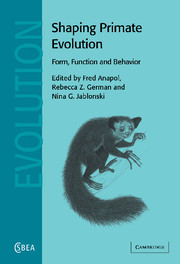Book contents
- Frontmatter
- Contents
- List of contributors
- Preface: shaping primate evolution
- 1 Charles Oxnard: an appreciation
- Part I Craniofacial form and variation
- 2 The ontogeny of sexual dimorphism: the implications of longitudinal vs. cross-sectional data for studying heterochrony in mammals
- 3 Advances in the analysis of form and pattern: facial growth in African colobines
- 4 Cranial variation among the Asian colobines
- 5 Craniometric variation in early Homo compared to modern gorillas: a population-thinking approach
- Part II Organ structure, function, and behavior
- Part III In vivo organismal verification of functional models
- Part IV Theoretical models in evolutionary morphology
- Part V Primate diversity and evolution
- Index
- References
3 - Advances in the analysis of form and pattern: facial growth in African colobines
Published online by Cambridge University Press: 10 August 2009
- Frontmatter
- Contents
- List of contributors
- Preface: shaping primate evolution
- 1 Charles Oxnard: an appreciation
- Part I Craniofacial form and variation
- 2 The ontogeny of sexual dimorphism: the implications of longitudinal vs. cross-sectional data for studying heterochrony in mammals
- 3 Advances in the analysis of form and pattern: facial growth in African colobines
- 4 Cranial variation among the Asian colobines
- 5 Craniometric variation in early Homo compared to modern gorillas: a population-thinking approach
- Part II Organ structure, function, and behavior
- Part III In vivo organismal verification of functional models
- Part IV Theoretical models in evolutionary morphology
- Part V Primate diversity and evolution
- Index
- References
Summary
Introduction
One of Oxnard's enduring contributions to primatology has been the demonstration of the value of multivariate morphometric methods in providing insights into patterns of morphological variation and their ontogenetic, functional, ecological, and phylogenetic correlates. Oxnard's studies have spanned the whole range of primates and a very broad spectrum of anatomy from the skeleton to the soft tissues of muscle and brain. He was one of the first to emphasize the importance of ontogeny in providing an interpretive framework for adult anatomy (Oxnard, 1984, Fig. 2.4). The work and ideas presented in this chapter continue this morphometric tradition. Thus we present a study of ontogenetic and adult variation in the facial skeleton of one group of primates using geometric morphometric methods. While these methods are becoming widely used, they may still be unfamiliar to many readers. The methods section therefore presents an outline summary of some relevant geometric morphometric tools before detailing the specific analyses employed in this chapter.
The study examines patterns of facial variation and ontogeny within and between three African colobine taxa. The ontogenetic origins of diversity in facial skeletal morphology of this group of monkeys have never been studied and yet they are interesting since, unlike the Asian colobines, they form a closely related, possibly monophyletic group (subtribe Colobina: Delson, 1994). This is suggested by the fact that they share quite a number of similarities including a vestigial thumb and shortened midtarsals together with postcranial and dental features (Szalay and Delson, 1979; Strasser and Delson, 1987; Delson, 1994).
- Type
- Chapter
- Information
- Shaping Primate EvolutionForm, Function, and Behavior, pp. 24 - 44Publisher: Cambridge University PressPrint publication year: 2004
References
- 4
- Cited by

